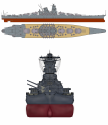Yamato was the strongest battleship from the perspective of a traditional battle line engagement of Jutland style. But the role of battleship has already evolved at the time of her commissioning, and she was by no means a satisafactory battleship design even for 1941, Much less the best.
Regarding the difference between the damage tolerance between Yamato and musashi, the torpedos used against musashi had traditional TNT fill. The power of those warheads were within the design tolerance of musashi's torpedo protection. On the whole musashi's torpedo defense successfully contained most of the torpedo hits against her central citadel. So she was lost in the end largely because of the damage and flooding in her unprotected front end, and the inability of the damage control party to contain those flooding. But the fact that she remained afloat for so long after being hit by 19 torpedos is a tribute to the fact that her torpedo defense largely functioned as designed.
The torpedos used against Yamato had torpex fill, which was much more energetic than TNT, and surpassed the design tolerance of Yamato' torpedo defense. So her torpedo defences were repeatedly ruptured by American torpedos. The fact that she took 12 torpedo to sink was therefore not a tribute to her effective torpedo defense. Her torpedo defense largely failed against the more powerful American torpedo warheads. It was instead a tribute to her internal subdivision and aggressive counter flooding.
A traditional line-of-battle engagement was the only role that battleships were built for, unless you count in shore bombardment. The role of a battleship never evolved, hence Yamato was objectively the strongest battleship in history. By 1941, no battleship was truly "satisfactory" considering how aircraft carriers completely dominated them for power projection. The Iowa's remained in service only because they had the speed to keep up with aircraft carriers, and not because they were much more "satisfactory" than other contemporary battleship designs.
As I mentioned above, Musashi managed to last as long as she did in part because of unintentional counterflooding due to attacks from both sides, whereas Yamato was attacked mainly from the port side. The type of explosive filler in the torpedoes, like you said, was also a factor, but not the only one. It was 600 lbs of TNT in the earlier variants of the Mark 13 torpedo, compared to the 600 lbs of TPX (900 lbs TNT equivalent) in the later variants, the former being under what the battleship's TDS was rated to handle (designed to withstand 880 lbs TNT), and the latter just above. Musashi's damage control was also reasonably good, while
Perhaps the most interesting point here is how Yamato managed to take 12 torpedoes before sinking, because by all accounts, she should have not been able to withstand so much. Contrary to what you claim, her internal structuralization was of little consequence, due to the fact that her weak armor joint ruptured every time her belt was struck by a torpedo, causing excessive flooding as the implosion of the lower belt would displace entire internal subsections. This was especially true for Yamato, as she was struck by torpedoes 50% more powerful than what hit her sister.

However, American air attacks concentrated mainly on Yamato's port side, as opposed to striking quite evenly on both sides for Musashi. This meant that counterflooding was entirely up to the damage control crew. Following the first attack, Yamato corrected a 5 degree list to 1 degree. Following the second, an 18 degree list corrected to 10 degrees. The third attack, hits by four torpedoes in rapid succession was what finally sunk her, and this could not be counterflooded because of the sheer amount of damage and flooding that she had already accumulated in the course of the battle.
All things considered, Musashi was able to withstand 19 hits due to three major reasons. The first was as you mentioned, that the torpedoes of the time had 600 lbs of TNT as filler and not TPX. The second was because she received attacks fairly evenly on both sides, which had the unintentional effect of counterflooding. The third was because her damage control wasn't incompetent, and they were able to keep most of the flooding contained, though they could not do much for the flooding in the bow.
Yamato took only 12 hits for the different sides of the same reasons: she was struck by torpedoes with 600 lbs TPX filler (900 lbs TNT equivalent), she was attacked mainly from one side (I think this is the more significant factor, because she capsized whereas Musashi did not) and her damage control was not as good as Musashi's. Finally, regarding the joint; both battleships could have survived even more hits if there wasn't such a design flaw in their belt armor, and this flaw brings into question if Musashi's TDS really withstood those 600 lbs TNT warheads as effectively as it was designed to.
This leads me to wonder if it was simply their massive displacement that allowed them to absorb as much damage as they did, because while decent, their torpedo defense system was still flawed.
Last edited:

